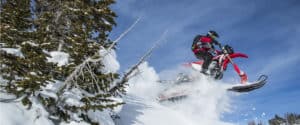The trend continues – technology makes it easier for more people to get farther into the less trammeled parts of public lands. Good planning would project future changes in technology over the life of a plan and – plan for it. I haven’t researched this question directly, but my impression is that winter travel planning (required by Forest Service regulations) mostly responds to the current state of technology. I’ve even seen statements like, “we don’t need to worry about closing these areas,” or at least “we don’t need to worry about people complaining if we close these areas,” because people can’t get to them. What happens when that is no longer true? NEPA requires consideration of new information relevant to environmental impacts, which may lead to changing a decision.
“Snowbikes” – I imagine there are some national forests that ought to be thinking about going back to the drawing board on their winter travel management plans (and maybe forest plans). Especially where there are snow-dependent species like lynx and wolverine that are listed under ESA (where new information must be consulted on) or at risk of being listed (and regulatory mechanisms are a consideration).
“After Polaris bought Timbersled in 2015, that’s when things took off,”
“The snowbike market is in its infancy right now, but it’s exploding,”
“It’s a riot,” “You can make your own line wherever you want to go.”
“They’re so agile,” “You’re able to get into places you never would get into with a snowmobile.”
“It’s just like riding a dirt bike in the woods,”
“For those who have never ridden a snow bike, the best analogy I can think of is this; it is like riding a Jet Ski on sand dunes. There is a freedom unlike anything else I have ever done.”

I think Jon’s point is right on but not with these “snow bikes.” E-bikes yes. Snow bikes… not so much.
Indeed, you can count me as highly skeptical regarding claims referenced in the article. Mostly marketing hype, IMO.
Also I strongly disagree with the notion that “snow bikes” can access terrain that traditional snowmobiles can’t. But you would have to ride sleds regularly to understand why.
Notwithstanding… Jon’s point is good. Our federal land managers aren’t very good at anticipating recreation trends (ATV, mountain bikes, e-bikes, geocaching as examples).
Back to my own experience, with Gallatin National Forest, now Custer-Gallatin National Forest. The same year that the current Travel Plan was finalized, fatbikes for riding on snow became mass produced. Thousands of these are used around the country now. Now 13 years later, by any measure fatbikes are a legitimate winter activity across all our National Forests. Yet Custer-Gallatin National Forest hasn’t improved winter bike access since 2006, the excuse being that the Travel Plan would have to be amended. As other forests have come to terms with this access conundrum, Custer-Gallatin won’t take up the task. Thankfully about 5 years ago Montana State legislature amended snowmobile licencing to allow fatbike riders to buy 3 year permit tags to enable riding on the groomed snowmobile routes. This move mimicked new regulation that Idaho had put in place. It’s a bandaid fix but fatbike riders took it anyway. Not only is it challenging to anticipate recreational trends, but there are some in the Forest Service who are also inept at addressing trends that are now 13 years old.
Greg, what did the other forests do? Amend their travel plans?
I don’t know what the other forests did. Every Forest completed travel Planning on a different time schedule, some before and some after 2006. But they have been able to find ways to accommodate winter fatbiking. Nearby examples that come to mind are trails in the Driggs – Victor, Idaho area that are jointly shared with skiers and bicycles, and trails in the Butte, MT area that are also shared.